Potluck Publics
Spring 2020
Columbia University, GSAPP
Critic / Anna Puigjaner (MAIO Architects)
Collaborator / Andrew Keung
El Ermitano, Lima, Peru
Awarded / Lucille Smyser Lowenfish Memorial Prize, 2020
Featured on / KooZA/rch, The Best New Architects, Columbia GSAPP
︎
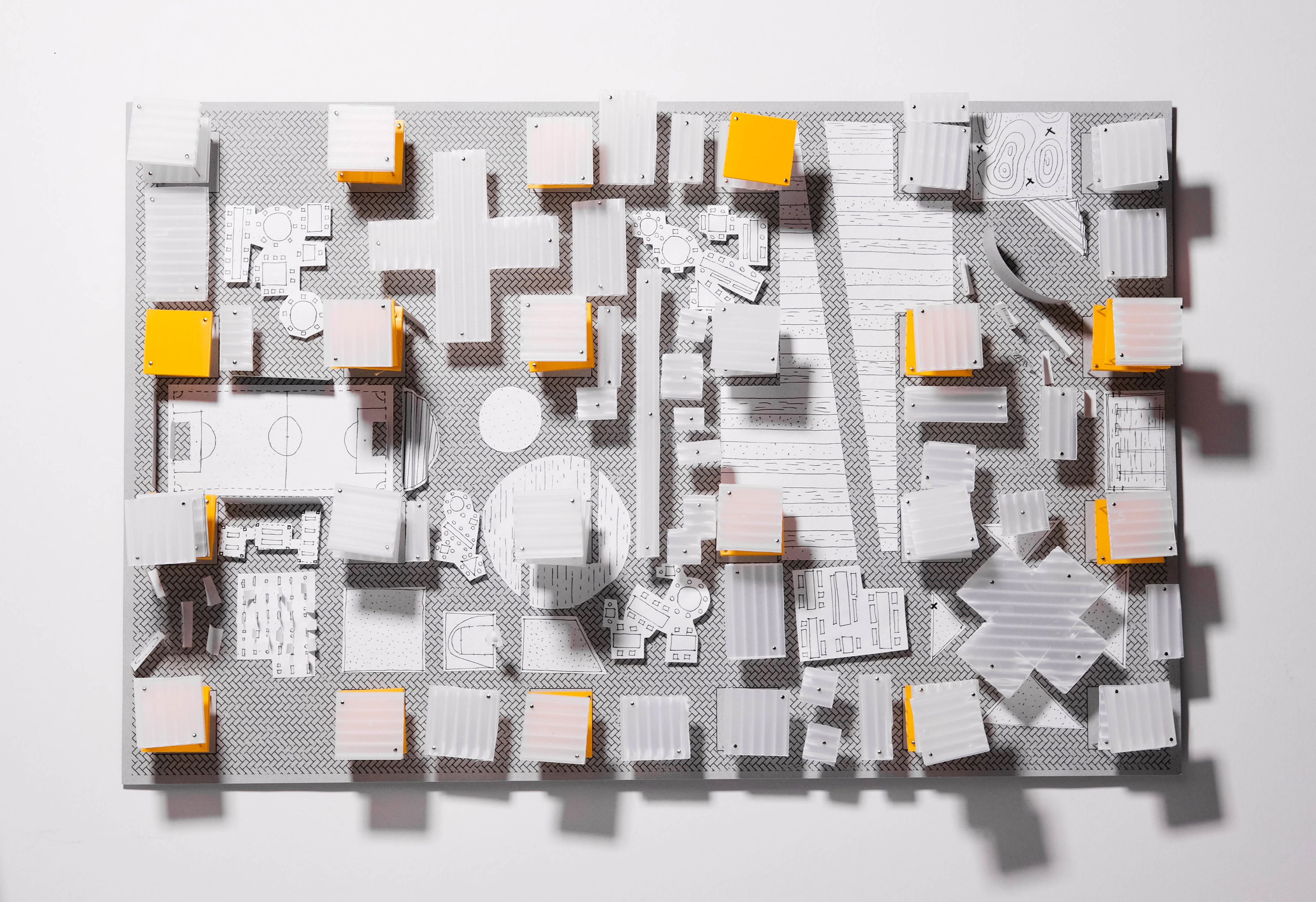
model / keyless domesticity, the formation of a multi-cellular domestic organism
Lima, since the 1940s, experienced an immigration downpour from its rural communities. Situated in a third world environment, the Peruvian government was unable to satiate the need for basic amenities and facilities in the countryside. These areas battled underdeveloped infrastructure, lack of education and healthcare, the dearth of work opportunities, and mass poverty. The move to the nation’s capital came from the search for economic opportunity and essential social and civic services and infrastructure. With power and wealth concentrated towards the western flank of Lima, inchoate and upcoming barriadas in the North and East foothills remain neglected and impoverished. One such neighborhood is El Ermitano, located on the western flank of the ridge. Since the cost of development on the hills is far more expensive than the lowlands, the State’s limited funds have the perfect alibi to not arrive in such underdeveloped neighborhoods. The residents at the lower rungs of the economic food chain, live with only legal squatting rights and devoid of basic infrastructure. With El Ermitano as a test site, this project explores the next phase of formal-informal negotiations.
What is visible is the trajectory rejoining the cult of neoliberalism which is at an impasse, and may well be terminal.1 With land pre-established as a commodified resource, experimentation for the sake of welfare is eclipsed by profit-making, splitting society into the haves and have nots. The latter is caught in a limbo of underdevelopment and neglect with dubious ownership statuses.
What is the next step in these negotiations? With the bottom-up restricted to self-help dwellings and mediocre urban decisions, can formal systems be re-engineered to provide greater informal agency and allow the bottom-up to support the State’s inadequate funds and unconscious intent? Can new scales and typologies of open-work be explored to limit top-down order and foster the barriadas’ innate social and vernacular piquancy?

collage / housing histories and the progression of open-work
Kitchen sink realism
The contemporary neoliberal environment establishes commodification as a prerequisite for free and fair trade. Of all commodities, “land is no longer a resource, or “standing reserve,” to plunder for the sake of profit.”2 Sitting comfortably in perpetual economic turbulence, capital players, who have also affected State intentions and obligations, siege the monopoly of income, landholdings, and other commodities. With widening economic and opportunity gaps, they have established themselves as ‘economy-resistant superbugs’ with little or no threat of any calamity or crisis. With power and wealth concentrated towards the western flank of Lima, inchoate or upcoming barriadas in the North and East slopes remain neglected and impoverished. As the city’s built fabric densified multifold over the past half-century, state funds do not reach the periphery (primarily hilly regions and peri-urban communities) equally as they are most expensive to develop.
Highly infectious, the urban sprawl of these barriadas grow up and over the foothills and linking new neighborhoods and countryside, consuming most of the natural ecosystem. Since the cost of development on the hills is far more expensive than the lowlands, the State’s limited funds have the perfect alibi to not arrive in such underdeveloped neighborhoods. Similar to the frazzling formal grid from the west to up the hills in the east (which is an obvious geographic response), the quality and quantity of formal infrastructure and civic amenities also dwindle. For example, not even central water lines reach the hills, enforcing a dependency on local water tanks that are filled with insufficient frequency. The players (people) of these barriadas resemble the proletariats and precariats of a social realism drama, trapped in the limbo of neglect, economic stagnancy, and constant architectural depreciation.
Architectural adaptation, systemic evolution
The collective kitchen emerged at a moment of political protest and domestic subsistence in barriadas. Intending to fulfill domestic nutrition, it overcame the problem of spatial and programmatic redundancy. The intersection of domestic labor with subsidized supplies promoted a new formal-informal negotiation. The comedores populares displayed the potential for restoring social idiosyncrasies and magnetizing additional urban development. What if this potential urban magnetism is bolstered to spawn local activity and additionally attract State and private funding for selective development?
Offsprings of collective living and shared resources, popularly discussed in contemporary architecture as commoning, emerge out of the effort of a community to pool its resources and share them equitably3 with a constant denial of human error. Since “resources are not owned but are a commonwealth”4, their prolonged existence as capital-emancipated assets is threatened by a materially infatuated and morally flawed social context. Unless existing in complete economic isolation with immaculate subsistence, commoning is likely to collapse under its vulnerability and loop back into terminal neoliberalism. Instead of perfecting a capital-free and morally upstanding collective society, one can allow its constant flaws, errors, and failures to behave as recurring moments of correction. Establishing systems of reciprocity, resources can function as toggles to allow targeted upliftment of such neglected barriadas. Turning architecture from formal and monumental entities to a set of deployable platforms and props, one can reverse engineer local economies into pseudo-capitalists to engage in the neoliberal world but benefit locally through an egalitarian agenda. This agenda of localized civil disobedience, bolsters the intent of commoning, mutating to a system of resource, economic and urban collaboration. The application of this collaboration lies in the ethos and potentials of the comedores populares. Extracting the ability of food and the collective kitchen to allure more urban and collective activity, they can become the central program of this civil disobedience.
A democratically instituted grassroot association is given the responsibility to execute hyperlink contracts and mobilize resident funds. Turning barriadas into an ensemble of hyperlinks, these contracts, governed locally and overseen by the State, re-arranges individual dwellings into legal families of collective contribution, responsibility, benefit, and governance. Through a social and economic potluck, small endemic economies can be reverse-engineered into pseudo-capitalists to engage in the neoliberal world, and simultaneously benefit locally through an egalitarian agenda, breeding ‘capital-constructive antidotes’.
The formal-informal dialogue is dissolved and reborn as a descendant-ascendant negotiation to alleviate the State from complete financial and political responsibility. State funds are limited to building and governing urban systems and infrastructure. These may include roads and bus stops, a denser network of politically colored staircases (endemic to Peru) and water tanks, retaining walls, initial investment on renewable energy systems, and the surveillance of grassroot contracts. The residents are levied with the responsibility to execute hyperlink contracts and small scale interventions.
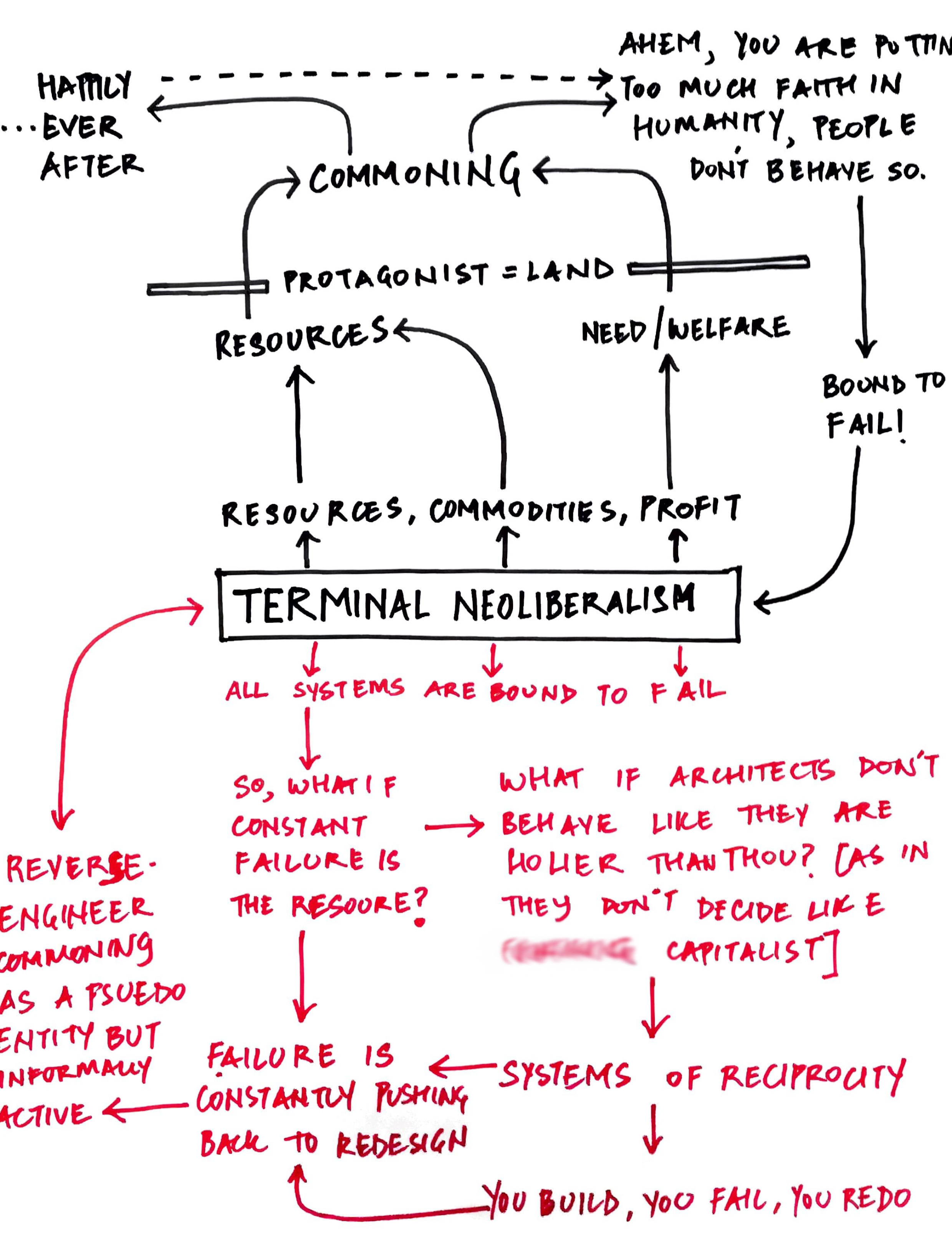


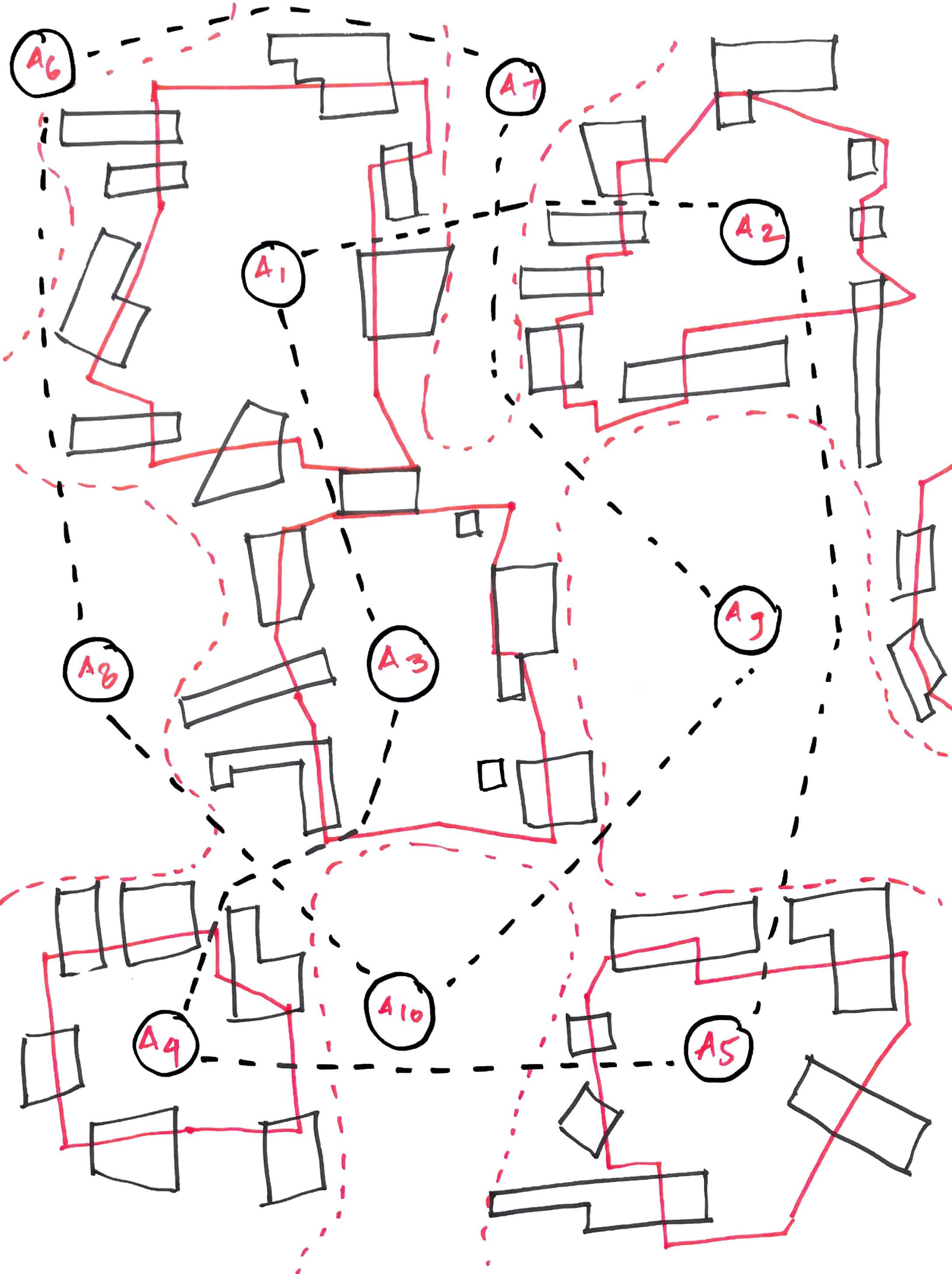
01. A case of terminal neolibralism. With pandemic commodification of almost everything, you are left with two routes - a “happily ever after” where humanity comes togther is heroic albiet romantic fashion and shares everything or the real option where humanity is a never learning parasite and returns back to its state of neoliberal capitalism and calls it “beinghuman”. Or a third way is to allow failures of humanity to be extracted as a resource and reapply as if the economiy was a series of controllable toggles and allow reciprocative behaviour and achive targeted results and socio-economic upliftment.
02. The dissolution of the binaries of labour. Domesitc and proctive labour is unified to produced one unbiased labour allotted to all genders and cultural and social divions. Labour is infact labour. (addition)
03. Respectiing the need for a private family or solo realm, the binary of public is private is maintained, but the singularity of th epublic realms is divided into tiers of absolutes and semis. Parts of the housefront fuse with the urban outdoors, parts mutate into urban indoors with economic and soacial functiosn and parts become semis or transitions between all. (reduction)
03. Respectiing the need for a private family or solo realm, the binary of public is private is maintained, but the singularity of th epublic realms is divided into tiers of absolutes and semis. Parts of the housefront fuse with the urban outdoors, parts mutate into urban indoors with economic and soacial functiosn and parts become semis or transitions between all. (reduction)
04. Once available to be plugged in to the urban outdoors, redefined households and housefronts are subjected to a social and economic gravitation where the interior and exterious housfronts and businesses are contributed collectively to form the potluck. This hyperlinking turns small solo businesses into more stable collective with profits, liabilities and advancedments shared leading to collective and beneift. The permanency of the private indoors and the fluidity of economic contracts, social milieu and urban furniture and props presents the area as a fusion of sedentism and nomadism.
05. To overcome problems of conflict or the emergence of unequal access and distribution, egalitarian beneift is placed as a supreme target by allowing potlucks to keep apprprating legally by allowing contracts to be rearrange businesses. This Turns the hillside into a living organism of economic and social activity.

collage / urban model - clustering, potlucking and sharing economic and political responsibility


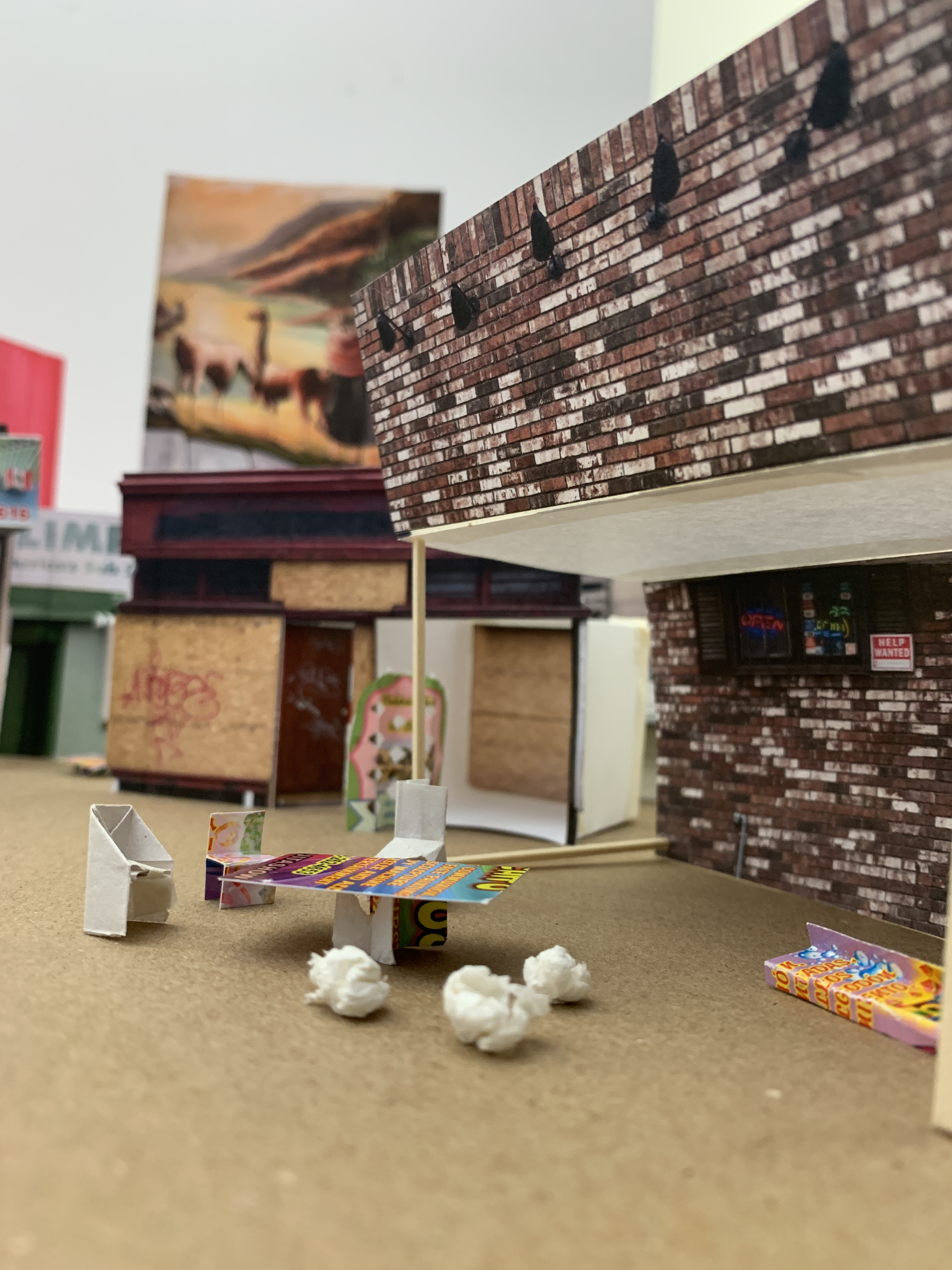

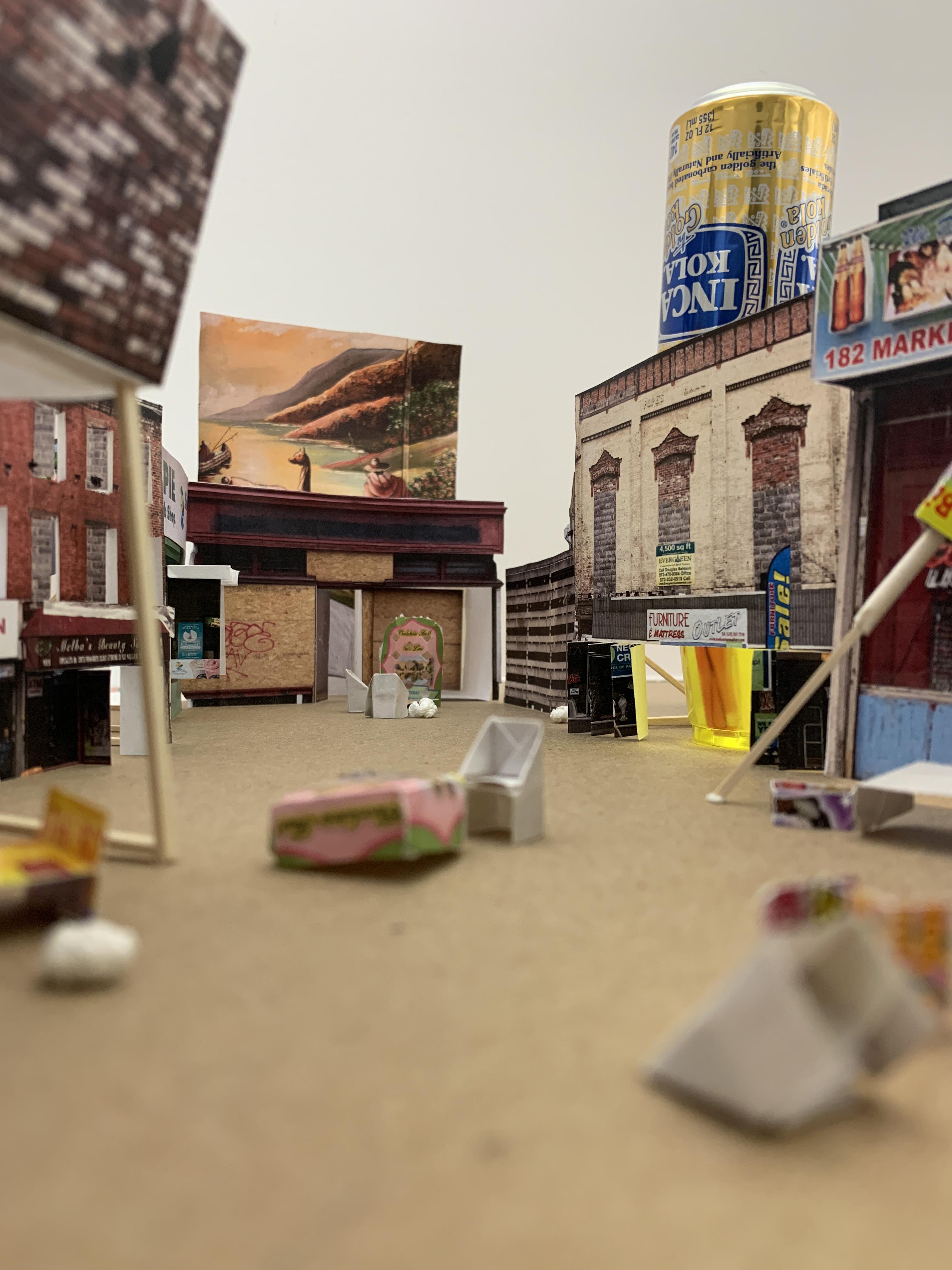

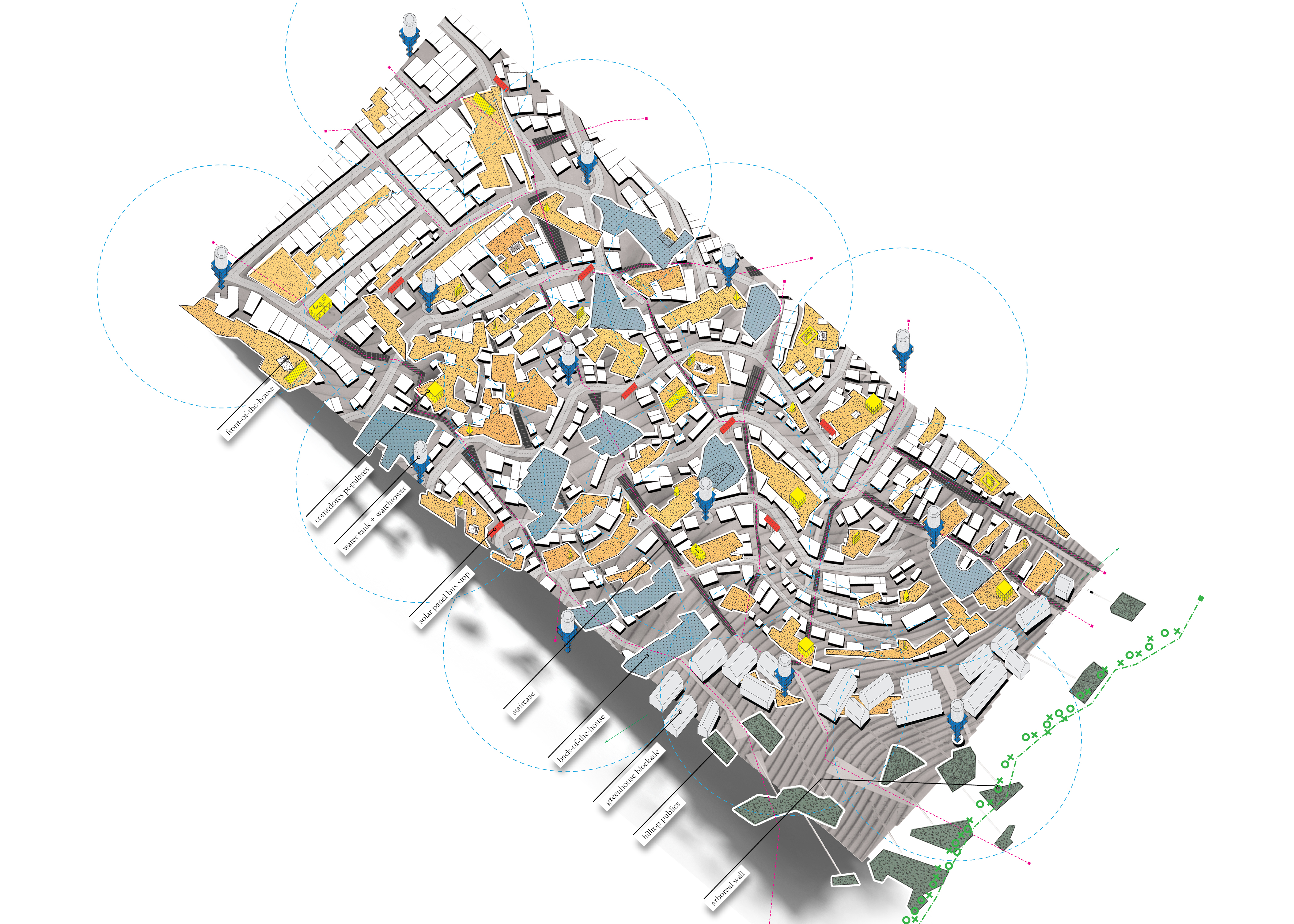

model, collage / urban model - 01 / social and economic hyperlinking to form potlucks; 02 / network of roads, bus stops and staircases; 03 / network of water tanks; 04 / blockage of greenhouses, 05 / spread of comedores populares; 06 / arboreal wall
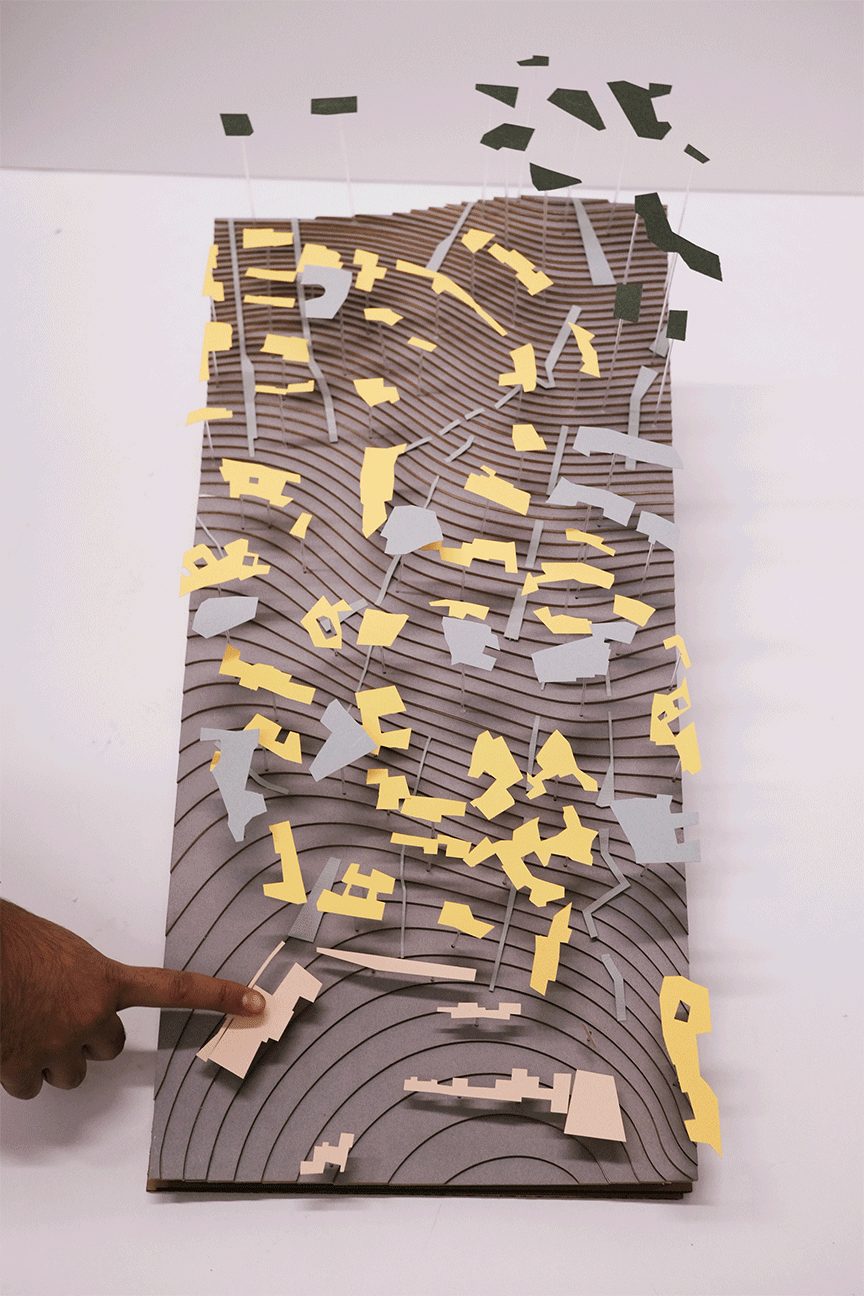
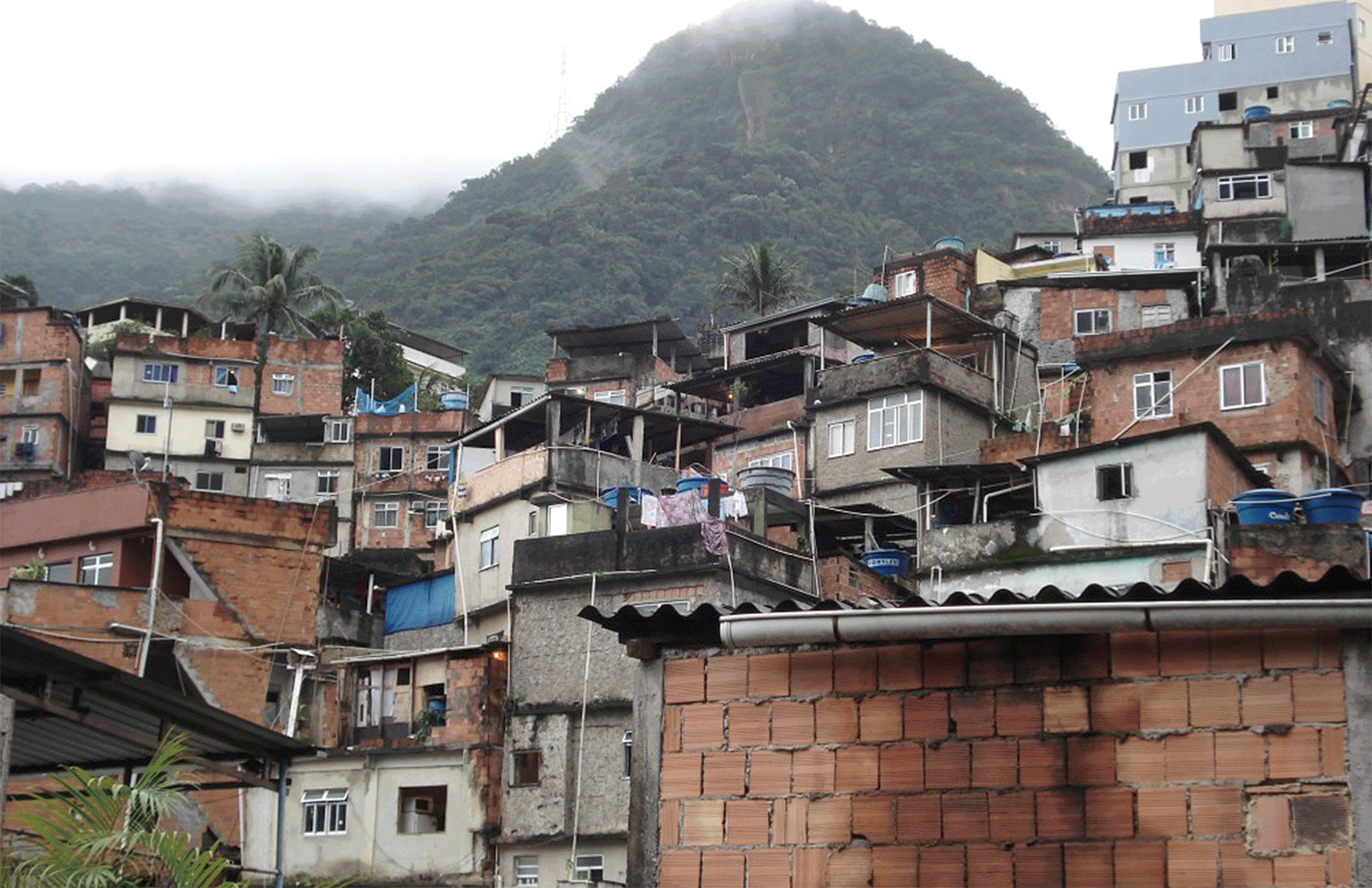
gif, model / tiers of potlucks
gif, images / settlemts on the hills, Lima
Labor is labor
The foundation of this reciprocity simultaneously lies in redefining the unit of space and program. Barriadas are characteristic of commercial, recreational, and domestic activity sprouting organically and coexisting in close proximity. Combining reproductive/domestic labor with productive labor, the domestic space is spatially united with commercial and institutional activity. The summation of space and labor, generates ambiguity, threatening clichés of gender-defined roles and bias against domestic labor. Spatial synchronicity of domestic and work spaces is experienced as a triad of untouched private interiors, publically accessible ‘housefronts’, and a potential urban ‘front-of-the-house’ for domestic and productive interplay.
The top-down-bottom-up milieu of the comedores populares is hence made contagious to be adopted by other domestic and non-domestic programs. The semantic and architectural reciprocity is experienced in the form of a collective land readjustment where housefronts in close proximity gravitate towards each other to form clusters or potlucks of accepted and contracted “familiality” and stewardship. This readjustment is also experienced as a collective contribution of private commercial spaces under a collective cluster contract where earnings are shared, ranging from walls to interfaces, to rooms and right up to complete floors, depending upon the domestic capacity and changing family units and needs.
Housefronts and potlucks
Housefronts display domestic mutation by either activating urban areas as domesticated spaces or temporally shifting from commercial to non-commercial activities. For example, barbershops become simultaneous living rooms with music entertaining customers, family, and friends. Schools function as institutions by day and cinemas by evening. Printing and repair shops become vocational studios. And collective kitchens interpolate between restaurants and dining rooms. Respecting the limited space, diverse needs and changing conditions, these front-of-the-house potlucks, celebrate barriadas as a natural social and urban system, eradicating the formal-informal divide.
John Turner‘s rationale for accepting barriadas as the form of development was based on them understanding what they need instead of being driven by an external force (i.e. State). The domestic unit exists as an island - a private untouched zone and a housefront behaving as an urban interiorization. Simultaneously, all domestic islands collaborate under contract as a collection of spatially contributing and economically sharing as a programmatic potluck. To activate another layer of reciprocity, these contracts bind dwellings through a lease system that may allow them to gravitate to another adjacent potluck based on changing needs. With room for amendments, this neighborhood of hyperlinks behaves like a living organism showing constant flux. Enabling both domestic and non-domestic activities, they allow for the sedentism of contemporary life to exist in parallel with the nomadism of their ever-changing needs.
Grassroot agency governs the realization and appropriation of collaboration contracts in accordance with altering needs. Instead of social currencies in commoning practices, capital and commercial gains of clusters can be used for both private and collective welfare after the proper discharge of funds. With smaller independent clusters, they behave as families, overcoming the diversity problem of large collectives and cooperatives.
Catering to more communal and public needs, back-of-the-house clusters can provide for congregation, demonstration, and recreation. Owned by the state but governed at the grassroot level, they can function as gardens, playgrounds, and larger healthcare and educational institutions.
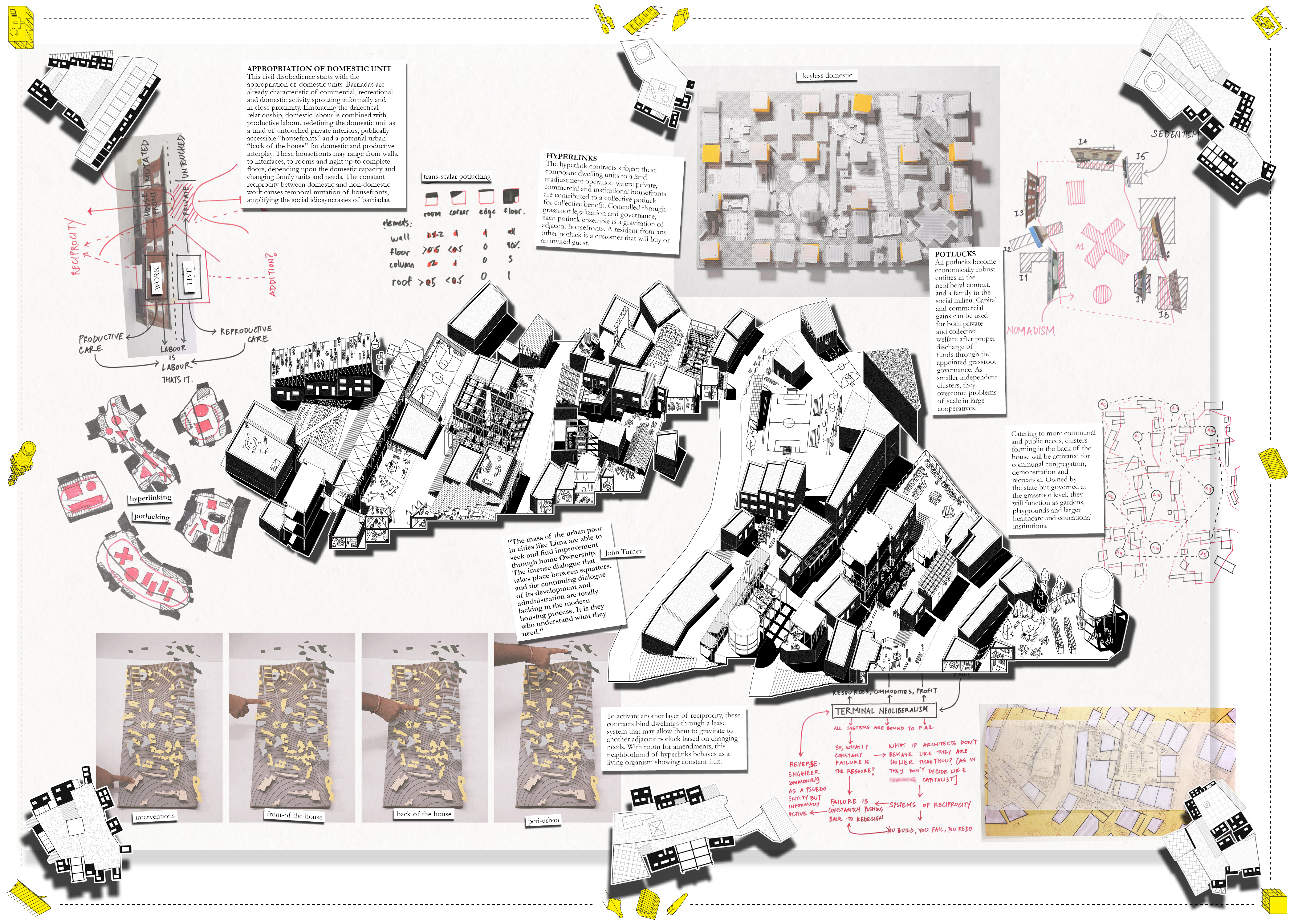
collage / interior, potlucking and hyperlinking


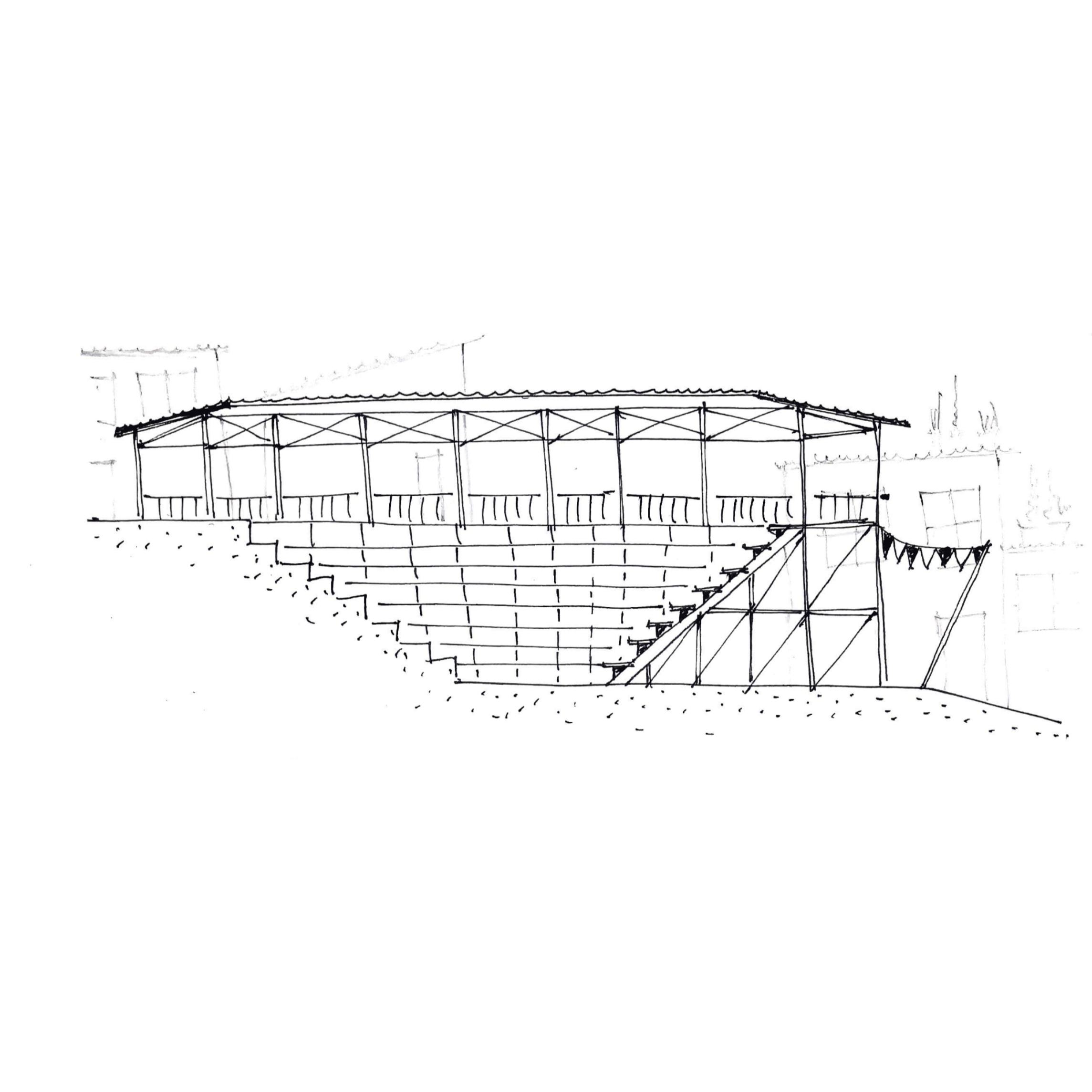
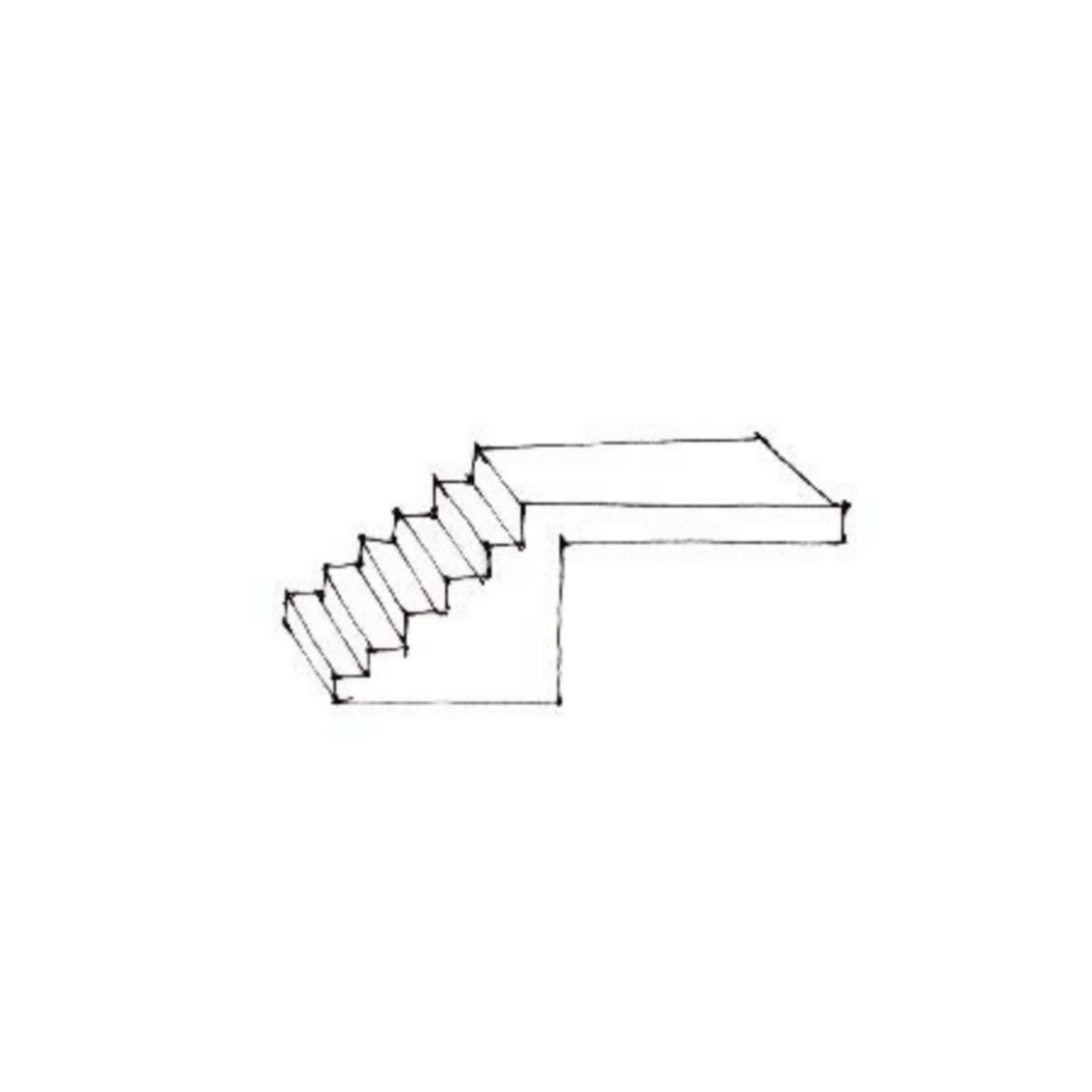
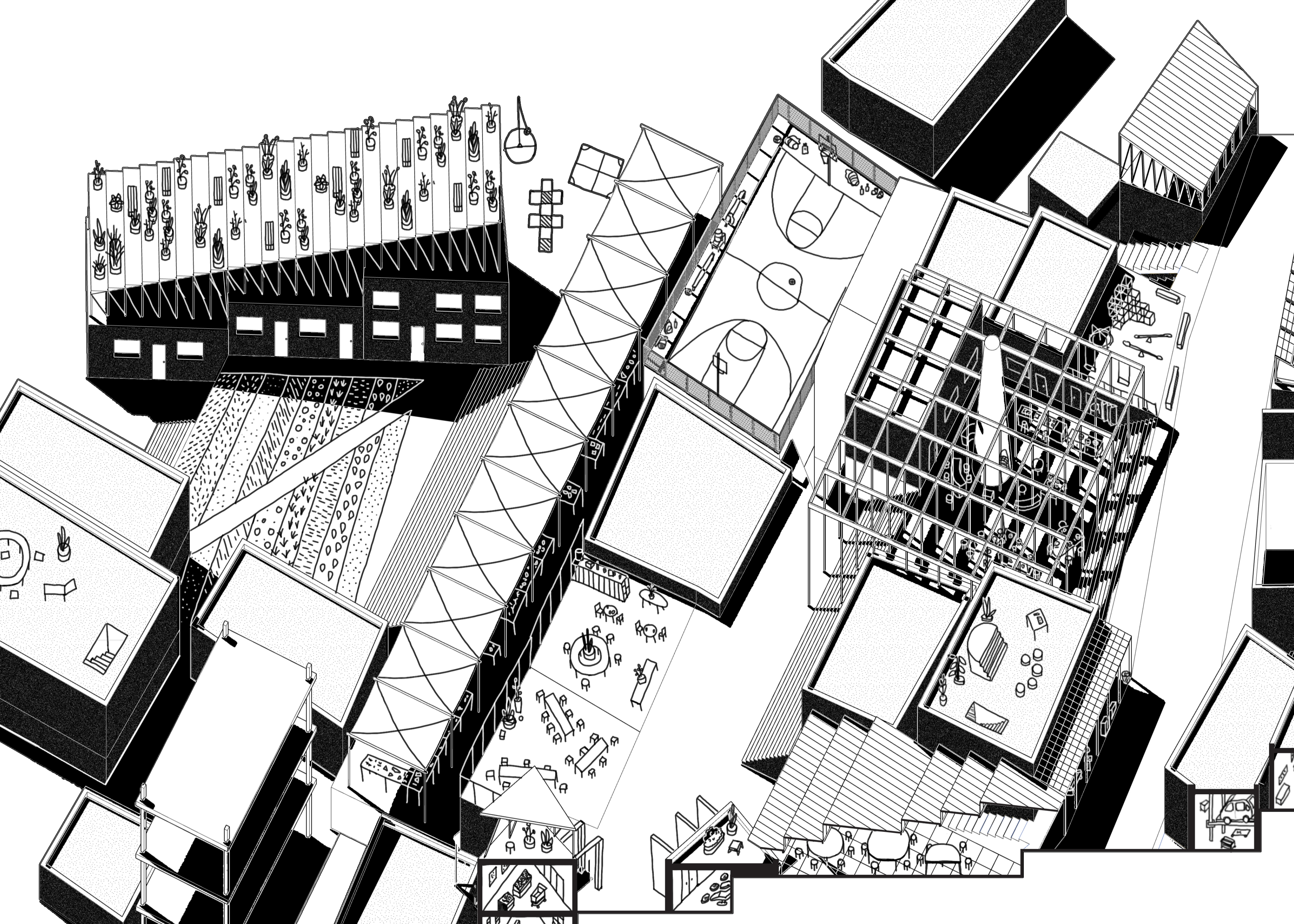



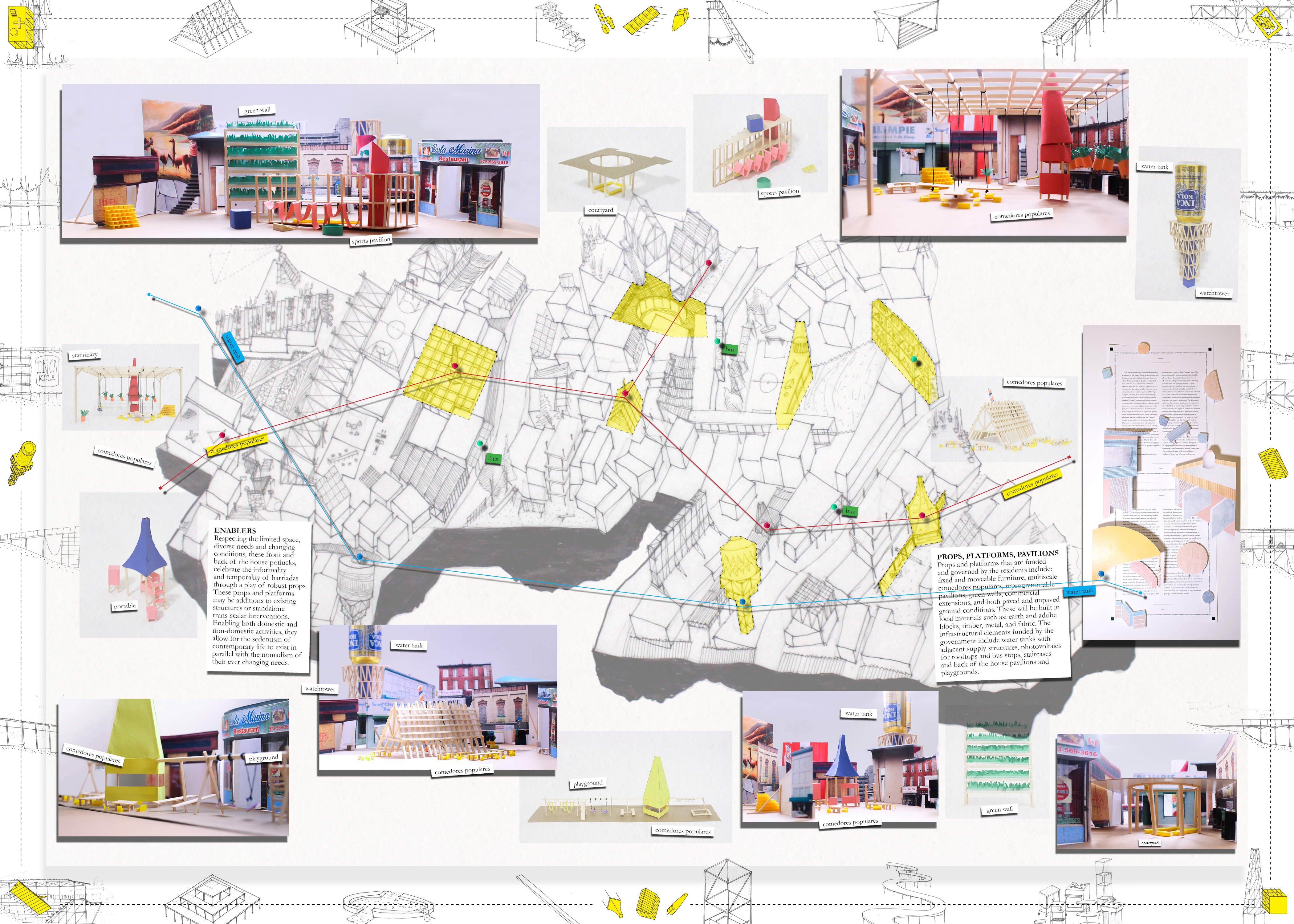
collage / intimate, platforms, pavilions and props
Patient zero
As confronted before, the onset of Lima’s housing troubles were caused by the massive immigrant downpour. With constant sprawl and densification, any form of reciprocity will eventually turn into compromise and effectively lead up to failure. Acute provincialism causes urban centers to turn into sprawls, effectively becoming cesspools of disease, poverty, friction, and even war.
Instead of only inculcating metropolitan resolution, stopping the city can help reorient the State’s focus to develop the countryside and rural areas. “While roads are often treated as the means to deliver progress and access, they encourage overdevelopment that destroys valuable resources embedded in forests and indigenous cultures.”5 Additionally, with the city growing to the top of the hill, the natural ecosystem of the hill and its seismic fidelity are jeopardized. This focus on “limit the city” is encouraged through three phases.
The first is overdevelopment of the already developed region of the hill by introducing hemi-structures to relocate small dwellings towards the top of the hill and making room for future immigrants. Like Athenian Polykatoikias, these structures will be inhabited for temporary urban needs when vacant and later occupied by newcomers to the neighborhood by simply introducing walls.
The second phase is the resurrection of the first wave in an urban context. Open fields and greenhouses will be set to form a blockade and transform the urban setting into a peri-urban one. Supplying to comedores populares, agriculture can receive the occupational upgrade and be repackaged as an urban profession.
The final phase to halt the city is by reforesting the top of the hill. Instead of a solid wall, an arboreal wall will restore the top of the hill as a natural ecosystem and also keep the soil intact, preventing landslides.


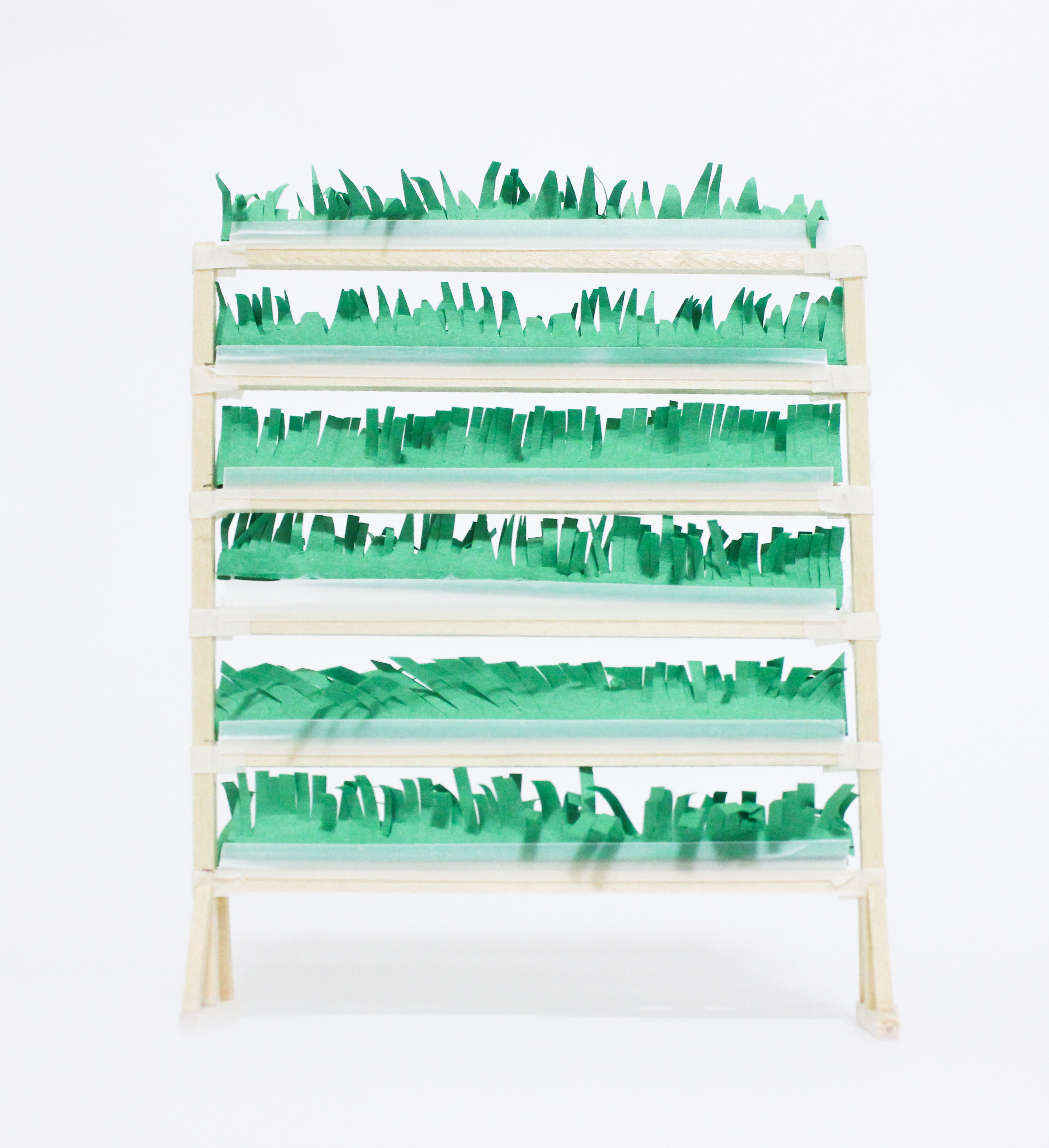

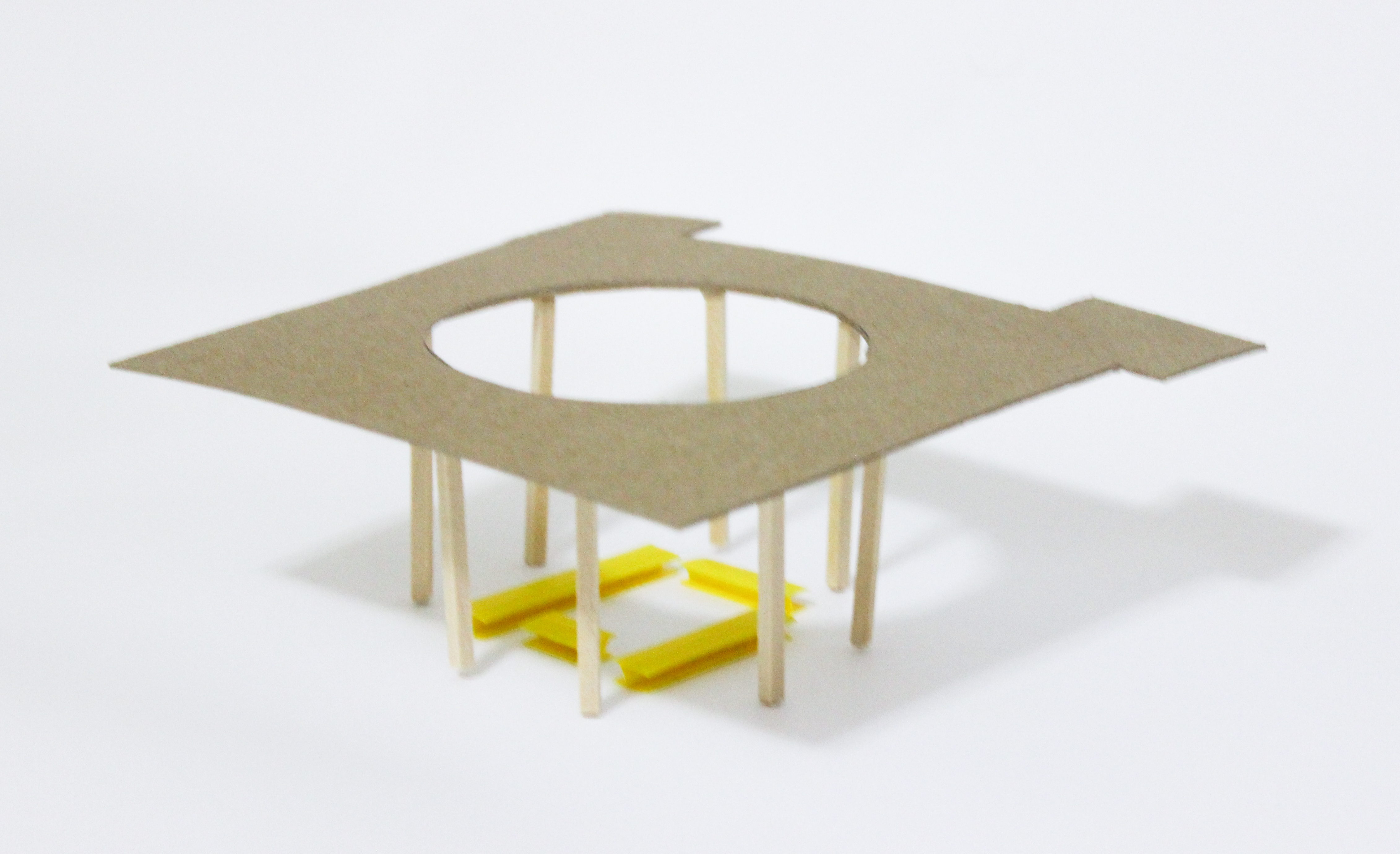
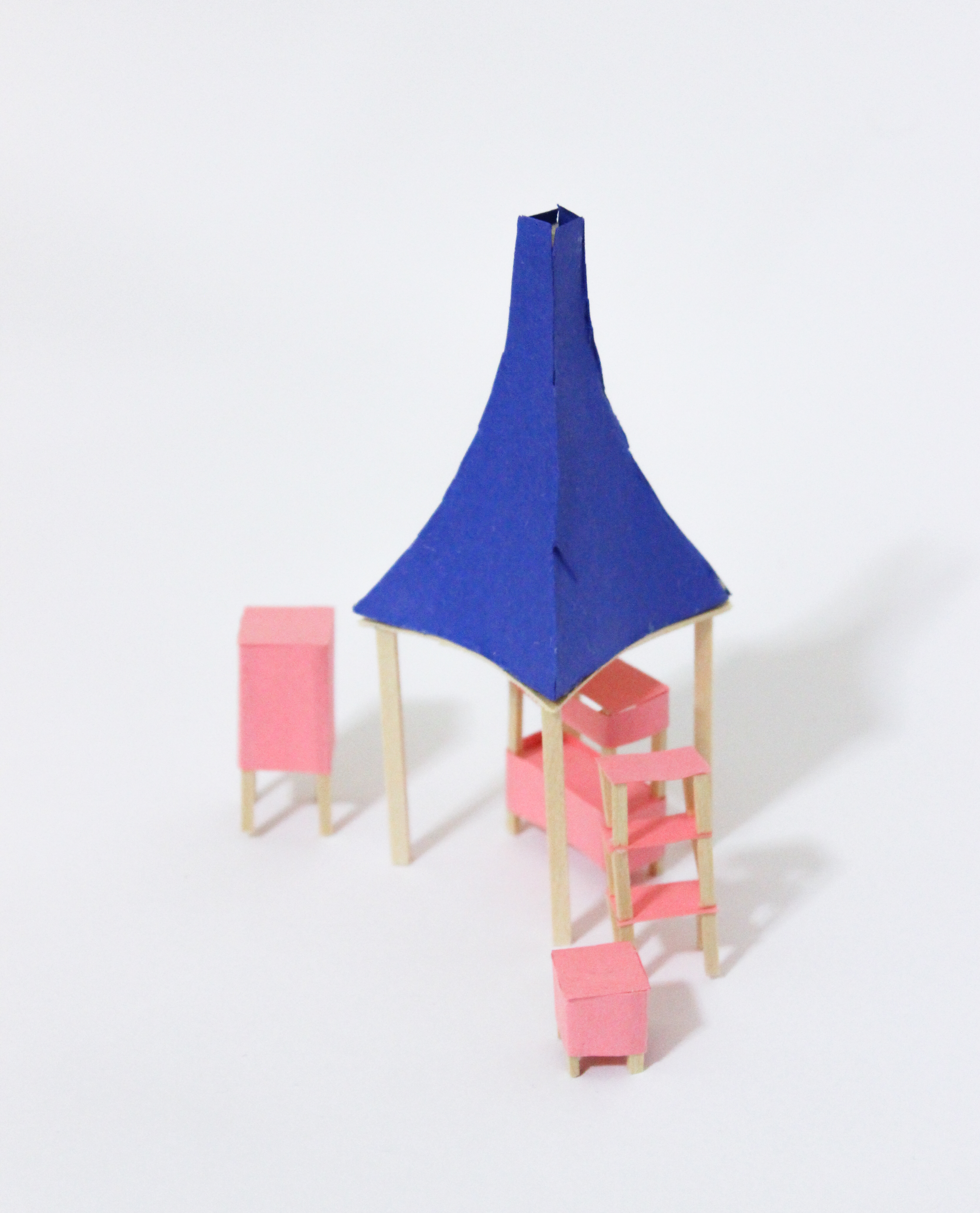






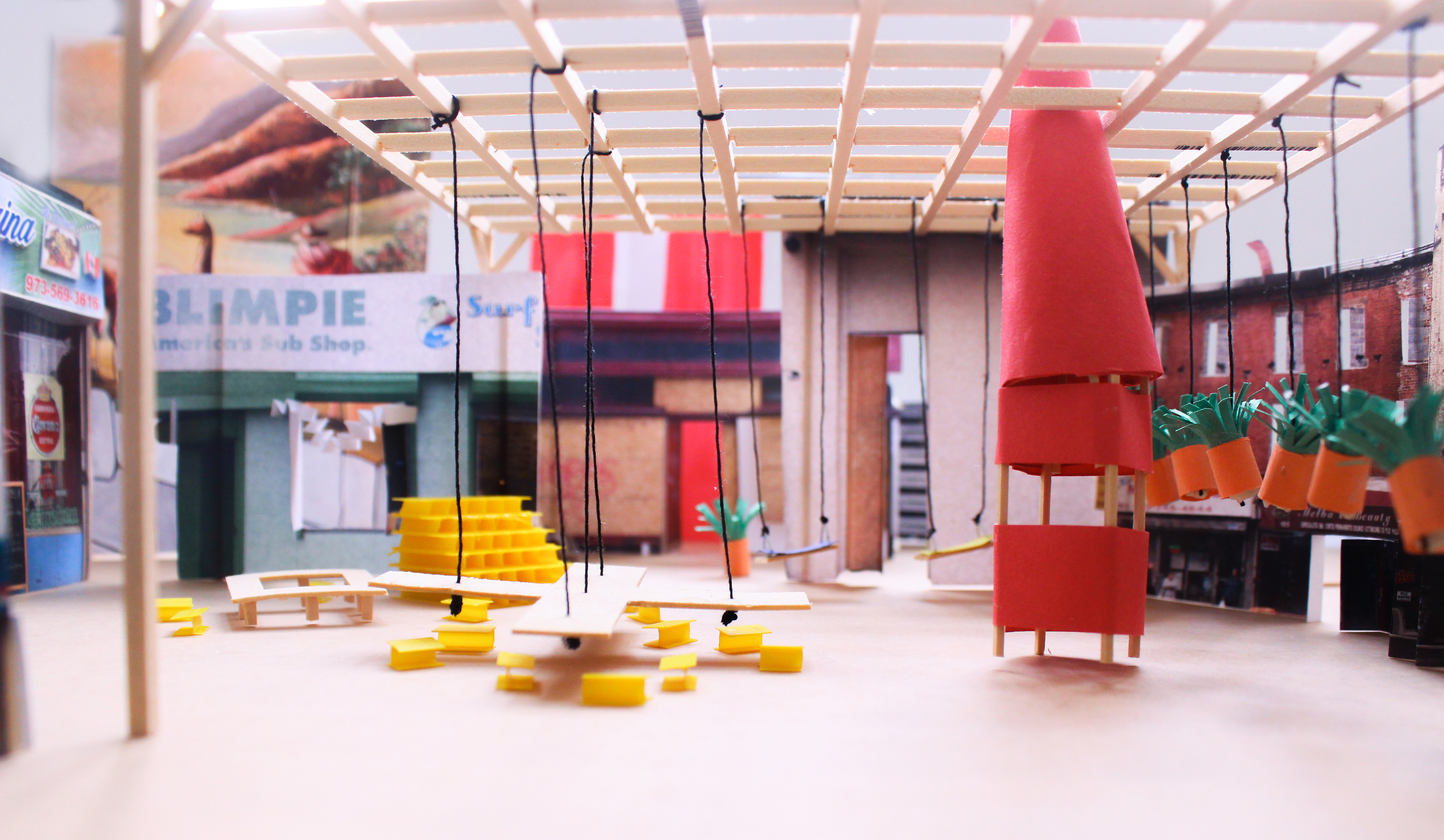
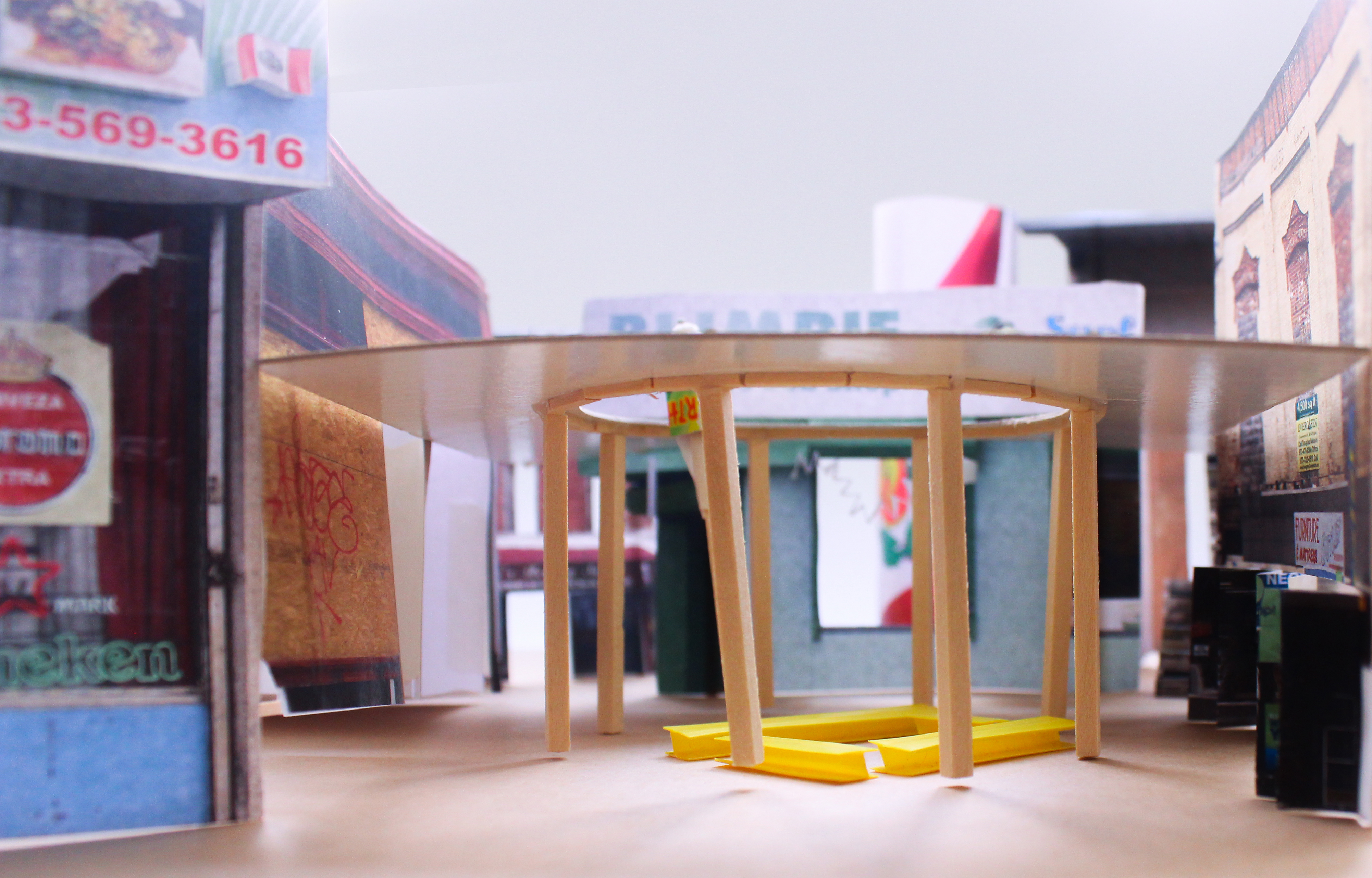
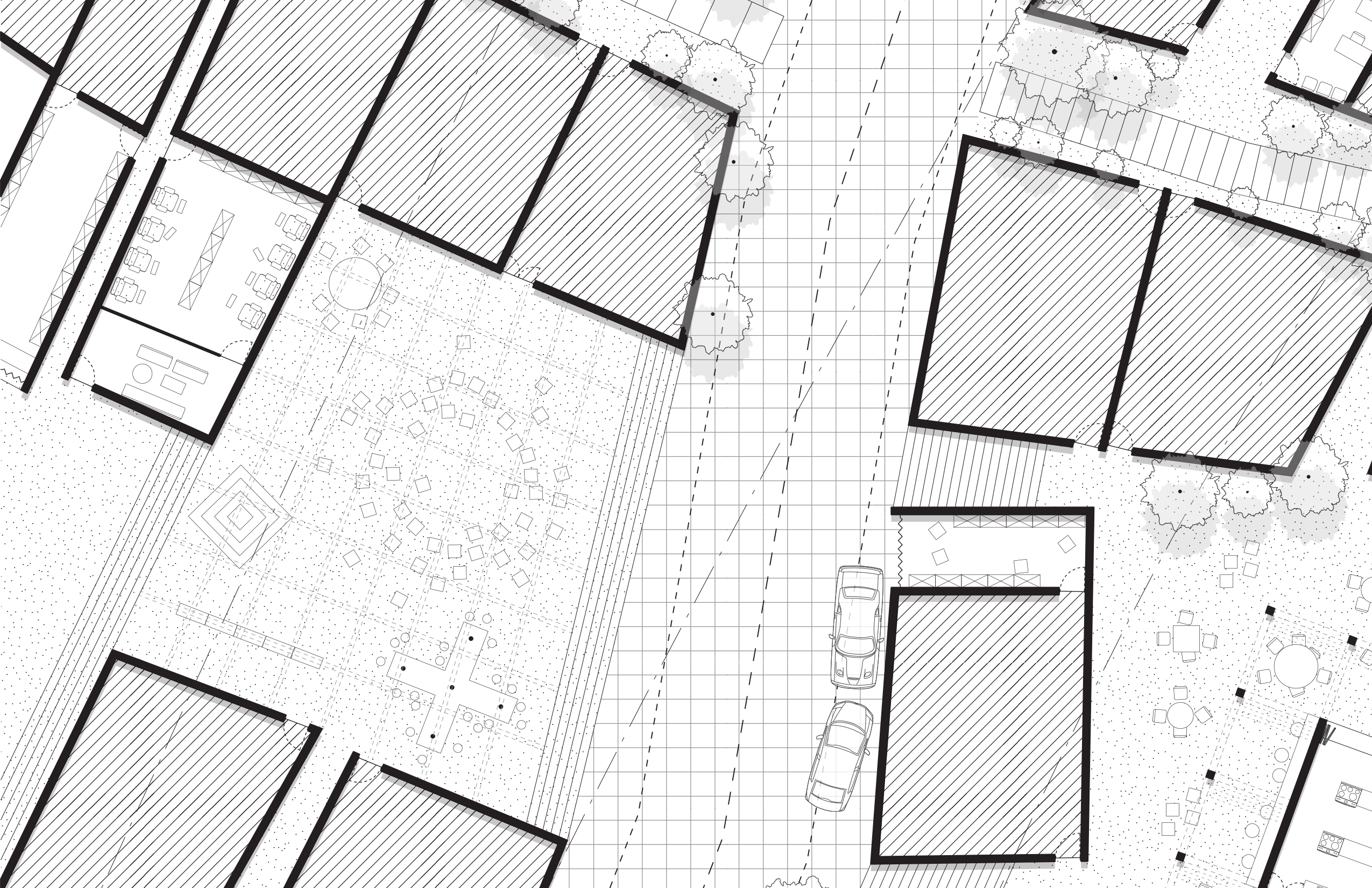
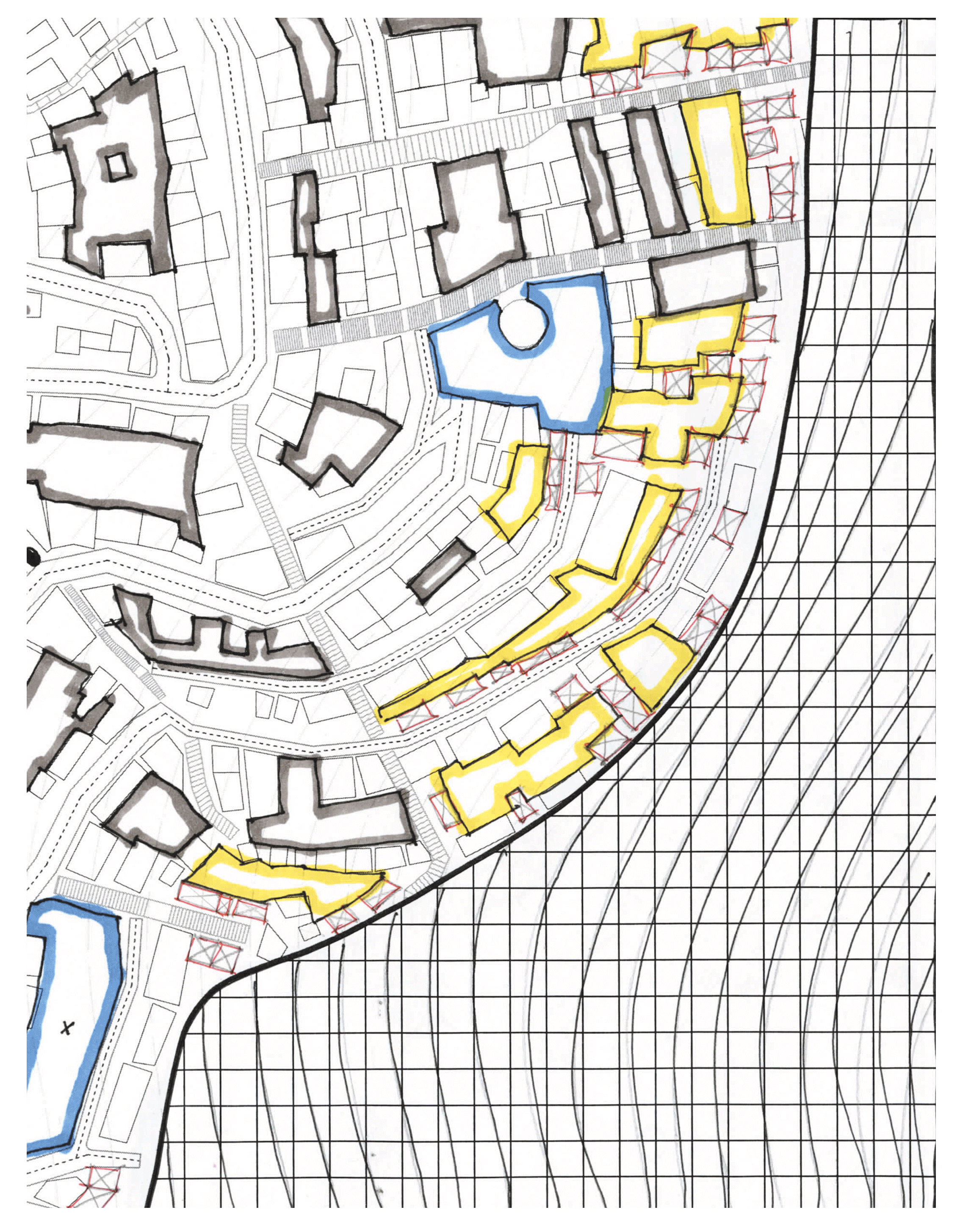
gif, plan / potlucks and reorganized housefronts - a collection of exteriorized domestic and non-domestic society
models / stopping the city - greenhouse blockade and arboreal wall
Semantic, systemic and civil evolution
The history of third-world civil disobedience has manifested through active revolt, boycotts, and denial. Instead of encouraging public enemies to “fight the power”, this civil disobedience is organized as constant friction between capital and welfare. Through a movement of kitchen-sink realism which means that one will confront everyday life in all its political and economic implications.6 The vernacular is reread as the quotidian or every day, and informality is no longer endorsed as the unorderly, chaotic and unpolished. Instead of being pedantic architects and planners, one can work with the idiosyncrasies of barriadas, to foster their maintenance, development, and economic and real estate appreciation. The projection of open-work is constant reciprocity of the centralized and decentralized through political and economic agency, urban upscaling, open-ended platforms for development, and overruling any personal endgames. This way these barriadas can collectively improve as co-capitalists in the neoliberal world yet foster inter-social contracts and communal piquancy.
×
References
1 _ Dimitris Papaioannou et al., “On the Commons: A Public Interview with Massimo De Angelis and Stavros Stavrides,” An Architektur - On the Commons, no. 23 (July 2010), https://www.e-flux.com/journal/17/67351/on-the-commons-a-public-interview-with-massimo-de-angelis-and-stavros-stavrides/)
2 _ Marx, Karl. Capital: A Critique of Political Economy Volume 1. Translated by Samuel Moore and Edward Aveling. New York: Cosimo Books, 2007. As cited in Aureli, Pier Vittorio, and Maria Shéhérazade Guidici. “Islands: The Settlement from Property to Care.” Log No. 47, 2019, 175–99.
3 _ Advanced Design Studio Kitchen Sink Realism.” Yale Architecture. Yale School of Architecture. Accessed February 12, 2020. https://www.architecture.yale.edu/courses/20256-advanced-design-studio-kitchen-sink-realism.
4 _ Ibid
5 _ Easterling, Keller. “Going Wrong.” e-flux. Accessed March 23, 2020. https://www.e-flux.com/architecture/collectivity/304220/going-wrong/.
6 _ Advanced Design Studio Kitchen Sink Realism.” Yale Architecture. Yale School of Architecture. Accessed February 12, 2020. https://www.architecture.yale.edu/courses/20256-advanced-design-studio-kitchen-sink-realism.
︎